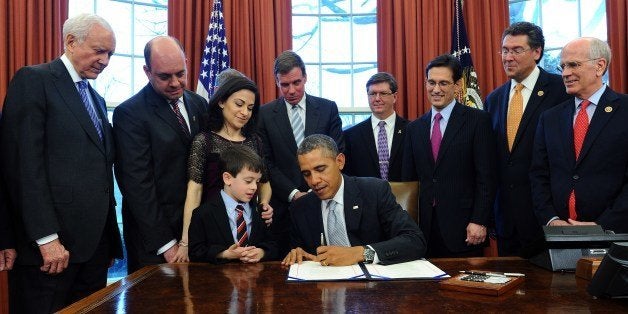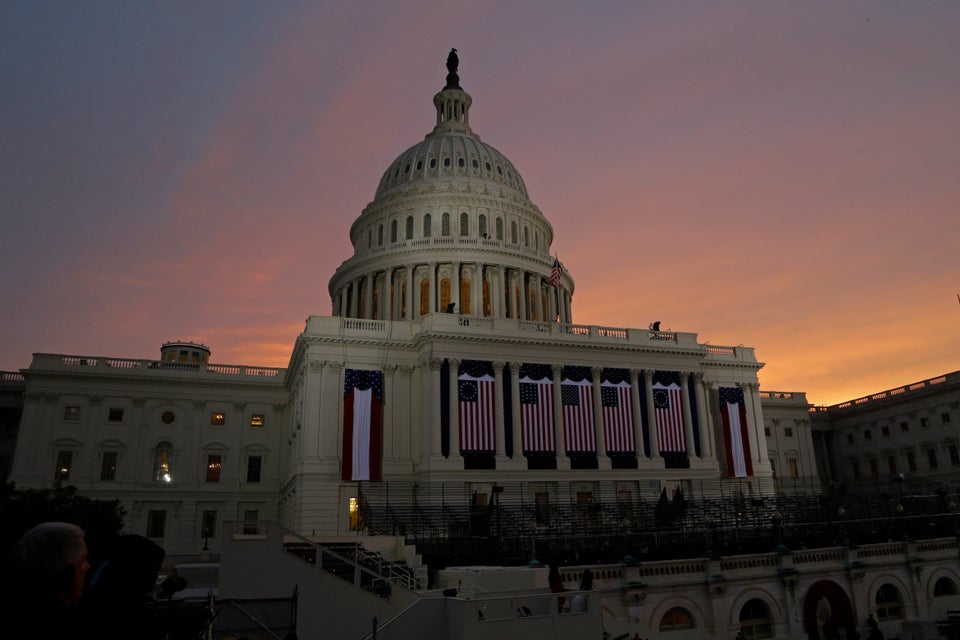
WASHINGTON -- Thursday afternoon at the White House provided political leaders from opposing parties a rare moment to celebrate together, as the president signed a bill devoting $126 million in the next decade toward pediatric cancer research.
After months of sometimes contentious negotiations, both the House and the Senate passed the Gabriella Miller Kids First Research Act in March. The bill, named for the 10-year-old brain cancer victim who, with her family, started the Smashing Walnuts Foundation, will potentially shuttle $12.6 million a year from funds for party conventions to the National Institutes of Health.
In an age of gridlock and acrimony, the law's passage was not viewed as certain. Conservatives wanted to use the money for deficit reduction, while Democrats remain worried that the funds will never actually be appropriated (they're only authorized under the law, meaning that Congress must pass funding in future spending bills). But after strong majorities moved it through both chambers, the White House followed suit. The president held a signing ceremony on Thursday alongside the bill's main advocate, House Majority Leader Eric Cantor (R-Va.), and other members of both the House and Senate.
As feel-good as the moment is, however, it's worth stepping back to see how much politicians have done in the aggregate for people in similar situations to Miller, who died last October. The same lawmakers hailing the $12.6 million being authorized for pediatric research each year signed off on an NIH budget cut around 120 times the size.
All told, the NIH's budget in 2013 was reduced by $1.55 billion because of sequestration. This meant roughly 650 fewer grants and an estimated 1,000 scientists who experienced a loss in funding.
Very few lawmakers were actually happy with the outcome. Funding for science and medical research continues to enjoy bipartisan support. When asked about the NIH cuts, members of Congress or the administration all insist they never actually wanted them to go into effect. But their distaste for the cuts wasn't enough to produce an agreement on a sequestration replacement.
After the mandatory cuts went into effect, it took Congress nine months to get its act together. The budget deal negotiated by Rep. Paul Ryan (R-Wis.) and Sen. Patty Murray (D-Wash.) in late 2013 put funding for the NIH at $29.93 billion for the current fiscal year. That was nearly $1 billion increase from the sequestration level, but still well short of where the NIH's budget stood prior to sequestration. Congress would have to pass the equivalent of 56 more Gabriella Miller Kids First Research Acts in order to get the NIH's budget back to $30.65 billion, where it stood before the budget axe.
The president's budget, released in March, goes a bit further. He proposed funding the NIH at $30.2 billion. This total, the administration estimates, could lead to 650 new research grants. But it wouldn't fully restore the damage done by sequestration. In fact, the total proposed by the president was roughly $300 million lower than the 2009 level. Adjusted for inflation, it would be $100 million lower than where NIH funding was in 2002.
A request for comment from the administration was not returned. But at a press availability outside of the White House following the president's signing of the bill, Cantor and others said that they hoped to find more money to devote to the NIH. They also argued that the law's value lay in the fact that it prioritized pediatric cancer research, which only gets an estimated 3 to 4 percent of NIH funding, according to Sen. Tim Kaine (D-Va.), a champion of the bill in the senate.
"We have a lot of different areas of the federal government that have now been reduced because of the fiscal squeeze that we are under," said Cantor. "What we are about today is making a priority out of pediatric medical research. And we chose to take money away from an area that taxpayer dollars perhaps shouldn't be spent on, prioritize those, put them toward a goal ... that perhaps families such as [the Millers] in the future won't have to suffer such a tragic loss."
"All of us want more money for pediatric research. We want more money for research generally," Kaine said. "And you know what, I think there is going to be a day where there will be more. The difference this bill makes is that when that day comes and there is more, we will have established the practice of trying to earmark moneys into pediatric research."
As a political matter, the Gabriella Miller Kids First Research Act was no small achievement. When Cantor, a vocal supporter of the NIH, first began pushing the bill, Democrats extended little support. Senate Majority Leader Harry Reid (D-Nev) was offended when Cantor put a video of Miller on his website, which took a remark Reid made during the government shutdown on NIH funding out of context. Other Democrats, meanwhile, worried that if they passed the bill it would endanger additional efforts to secure more funding for medical research.
Cantor built coalitions and momentum, though, and the bill ultimately passed the House by a 295-103 vote. The Senate adopted it by unanimous consent on March 11.
But as lawmakers celebrate the signing of the bill, advocates in the science and medical research community are fretting the larger cuts elsewhere.
"It's time for we advocates to hold lawmakers' feet to the fire," said Benjamin W. Corb, director of public affairs for the American Society for Biochemistry and Molecular Biology. "We don't control the appropriations process ... And our funding is greatly affected. Lawmakers all tell us they support basic research funding. Now is the time to pay more than lip service to this community, and show support by measurably increasing budgets so we can recover from austerity."
The budget introduced by Ryan this week, for example, would cut $791 billion from non-defense discretionary spending sequestration caps. The budget doesn't specify how much of this would come from the NIH. A Ryan aide confirmed that members of the appropriations committee would decide that number, should the budget ever be enacted into law (it won't be). But it is extremely difficult to achieve that type of cut without touching the NIH's budget. In short, it would likely wipe out the gains from the Gabriella Miller Kids First Research Act and then some.

